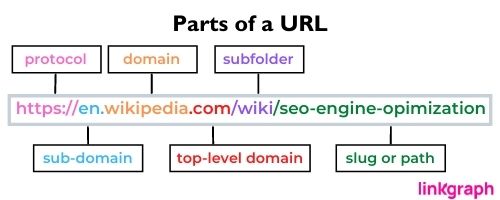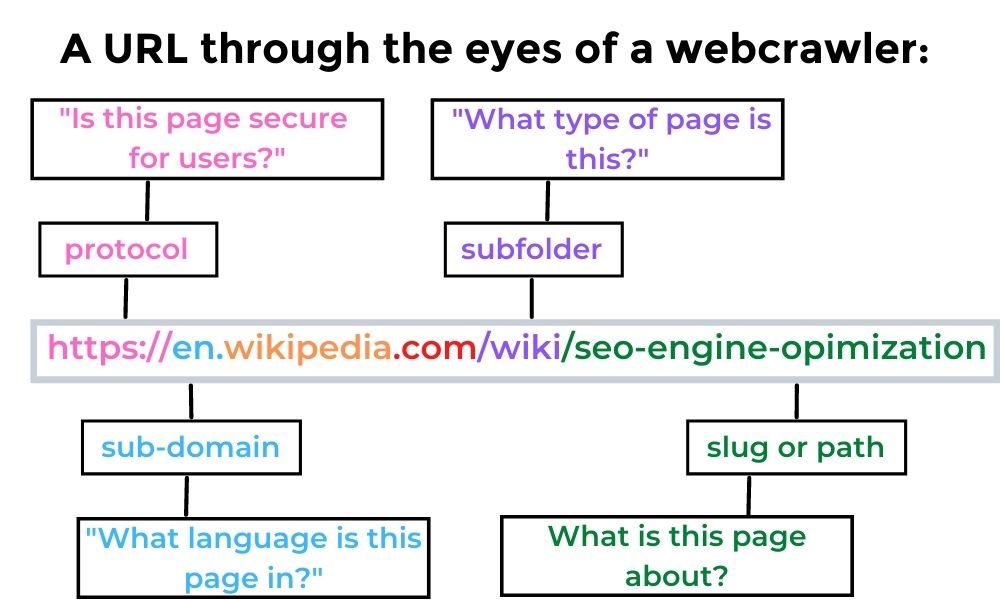How to Write SEO-Friendly URLs
When it comes to search engine optimization, the details matter. Why? Search engines analyze and index page details and these details add up to a recipe for […]
When it comes to search engine optimization, the details matter. Why? Search engines analyze and index page details and these details add up to a recipe for success in search engine results. While many people overlook the importance of URLs, we urge you not to underestimate them. Creating SEO-friendly URLs from the time of a page’s creation can eliminate compounding issues in the future and give you a competitive edge in the SERPs.
TLDR: URL best practices will save you time, money, and stress while improving your site’s crawlability. And this article will teach you how to optimize every URL you create.
What Exactly is a URL?
Every URL, or uniform resource locator, is unique. Why? Because every URL is only associated with one web page. As the name implies, a URL is a unique address that a web user enters into a web browser (such as Google Chrome). After hitting ‘enter’ on the address bar, your web browser sends a request to the server where the URL’s data lives. The server then locates or retrieves the web page (or “resource”) and sends the data page to the browser to present to the user.
Understanding the Parts of a URL
You likely noticed that every URL is a string of characters, often including letters, numbers, periods, slashes, and colons. Furthermore, you likely noticed that these characters follow a pattern. This pattern denotes specific information.
The Protocol
The first element of every URL is the protocol–either https:// or HTTPS://. This is the protocol or instructions for how the data sent between a web browser and servers are handled. HTTPS is a more secure information delivery system with data encryption.
The Subdomain
A subdomain is a part of the main domain that delineates different versions or parts of a website.
For example, a website that has a shop may have a subdomain that denotes that the page the user is a part of the online shop rather than the blog. You will also find language subdomains such as en, de, es.
The Domain
A domain name is the root of the URL and represents the overall website.
The TLD
The TLD or top-level domain indicates the category or type of website (to an extent). For example, “com” stands for commercial.
Subfolders
Many URLs also contain subfolders (also called subdirectories), these often act as one more level of organization (similar to how folders on your Google Drive allow you to organize individual files).
The Slug
The final element of the URL in our example is the page designation, path, or “slug.” This is where you must refine the text while optimizing your URL for SEO.
How URLs Affect SEO
Search webcrawlers, including Google’s, use a wide array of elements on a page to better understand the content on that page and the overall website. Two elements of a web page that search engine bots analyze to index a page are the URL text and URL structure.
More importantly, writing a URL in a search-engine friendly manner the first time helps you avoid rewriting it in the future and requiring a redirect. Why avoid redirects? Redirects require a server to first look in one location then move onto another location to retrieve the web page data. And while this is often only a fraction of a second, this time can compound during a search engine crawl leading to site load speed issues that can worsen the user experience.
How to Write Search Engine-Friendly URLs
Luckily, writing SEO-friendly URLs is straightforward and easy once you understand the foundations. This section will outline how you can create evergreen URLs that webcrawlers can easily understand and that will last the lifetime of your site.
1. Use Your Target Keywords Wisely
Keyword-driven content is the heart of good SEO. In fact, it’s pivotal to SEO, that your keywords should extend to your URL text. Your primary or target keyword should appear in your URL text. If it makes sense to put it at the beginning of the page locator, then do so, but do not force.
You should also avoid keyword stuffing your URL. To do so, be sure you use a relevant keyword in relation to your page content. Descriptive keywords also result in a better experience for users and webcrawlers.
Examples:
Good: unlawn.org/never-cut-wet-grass-again
Bad (keyword stuffing a URL): unlawn.org/never-cut-wet-grass-again-avoid-cutting-wet-grass-stop-wet-grass-cutting
2. Keep It Short & to the Point
Shorter URLs are more user-friendly than long URLs. They also pair back any information that may be confusing to search engine crawlers. Using a shortened version of your page title often results in an accurate and short URL.
While Google denies URL length as a ranking factor, studies show that the highest-ranking search results often contain a total of 50 to 70 characters, including the root domain, subdomain, and page text.
When deciding on what to decide and what to omit when crafting your URLs, you will want to omit extraneous words or characters, including:
- articles (a, an, the)
- conjunction (and, but, so, because, since, etc.)
Shorter URLs improve the user experience and make your pages easier for search engine crawlers to understand.
3. Use Hyphens to Separate Words
When words are shoved together without separation, web crawlers’ NLPs struggle to understand the individual words. To avoid this problem, place hyphens between words in your URL. This makes your URLs easier to read for webcrawlers and searchers.
Example:
Good: www.linkgraph.com/blog/seo-outsourcing-guide/
Bad: www.linkgraph.com/seooutsourcingguide
Why does readability matter for searchers? Your URL path appears in the SERPs. And searchers do read them in order to understand the page they’re going to click onto. The hyphens in the URL improve the user experience of the person scrolling through search results.
Why not use underscores instead of hyphens in your slug? To put it simply, Google recommends using hyphens to make a URL easier for their bots to understand. Underscores add complexity which can confuse and slow down a crawler.
Why not use spaces in a slug? Spaces in a URL are converted into code. You may have even noticed them in the past. They transform into %20.
For example, example.com/how%20grooming%20your%20dog%20at%20home As you can see, this switch renders the URL more difficult to read and much longer–neither of which is ideal for a web address.
4. Use Lowercase Letters
Many people don’t realize that URLs are, in fact, case-sensitive. And while Google’s John Mueller contends that Google doesn’t care if you have capital letters in your URL when it comes to ranking signals, we argue that all lowercase is still best practice. And here’s why:
1) Having a mix of uppercase and lowercase letters look bad and are just generally a little more difficult to read. It turns out all lowercase letters result in a more readable URL. (I’ve also noticed that this practice is done more often by people that simultaneously do not use hyphens).
2) Having all uppercase letters looks like the URL is yelling at the user.
3) People have to put in more effort to type with caps. (If you’re thinking “but they get to the same page either way,” keep in mind there are users that do not know that. And note our next point).
4) A URL with differing capitalization counts as different page styles can cause duplicate content issues to crop up unless you employ correct canonical tags). Without correct canonicals, you may get flagged by Google for duplicate content–or find the wrong version of your page appearing in the SERPs.
Just to help you better understand #1 and #2 above, here are some examples:
1) Good: www.linkgraph.com/best-seo-practices-for-beginners
Bad: www.linkgraph.com/Best-SEO-Practiced-For-Beginners or www.linkgraph.com/BestSEOPracticesForBeginners
2) Good: www.linkgraph.com/best-seo-practices-for-beginners
Bad: www.linkgraph.com/BESTSEOPRACTICESFORBEGINNERS
5. Do Not Omit Important Modifiers
For a very long time, you would hear that you should always leave out “stop words” in your URLs because they just take up space. And this was true–for a while–and still is when it comes to articles and conjunctions.
However, with Google’s BERT algorithm (an NLP algorithm that processes human language), Google often ignored prepositions since they were seen as minor signals in relation to content meaning. However, over time, the Google team realized that these words often add a lot of contextual meaning to searchers’ intent.
For example, someone looking for “restaurants nearby downtown Nashville” is has a slightly different intent than “restaurant in downtown Nashville.”
So, if the word is important to understanding the category of the content on the page, keep it in your URL.
6. Avoid using special characters
Special characters tend to clutter your URL. They’re also a bit more ambiguous in meaning than words. Therefore, it’s best to leave them out. Another way to think about this rule is that you never want a user to to be confused if you were to tell them what to type.
For example: if you have the URL
example.com/SEO-&-so-much-more, the user would likely type out “and”.
7. Omit unnecessary numbers
Why remove numbers from your URL text? Content re-optimization is a possibility for any blog post. When you have a number in your URL, you’re not leaving your content room to grow in the future. And if you do change the number of items on a list-style blog, you wind up needing to create a new URL and a redirect.
For example: numbers in a list (ex: 7-ways-to-improve-your-running-form)
8. Reduce the number of subfolders
When it comes to subfolder best practices, keep it simple. While a short URL is easier for searchers to scan, subfolders also tell Google more about the organization of your page through category name. Your subfolders tell Google more about the organization of your page, but Google does warn that having a list of subfolders can lead to a long URL that isn’t as easy for users to understand at first glance from the SERPs. Having several subfolders in your URL structure also signals to Google that the content may be less important.
When creating subfolders, remember to keep your category names concise to reduce the risk of an overly long URL slug.
Other Questions Regarding SEO and URLs
So, when it comes to creating URLs, use the guidelines above. However, we know that sometimes we don’t learn about the magic of SEO until we’re 100+ pages deep. We’ve got you covered. This section will go over that and answer those other questions many people have about URLs and SEO.
Q: I have a lot of pages that don’t follow URL best practices. What should I do?
This question comes up time and time, again: “Should I change my URLs just for SEO?” The answer is, “it depends.” When it comes to URLs, you have a few choices for re-optimizing (or not) existing URLs.
- How ugly/bad is it? If it’s really bad, then change it, but make sure you set up a redirect.
- Has it be redirected before? The last thing you want is a chain of redirect. If this is the case, and the URL isn’t that bad–leave it alone.
- Did the content change? If the URL is no longer relevant to the page, change the URL.
- Is the URL creating keyword cannibalization? Then change the URL to reflect another keyword that the page could rank for.
Q: Does my domain name affect my ranking?
No. Google doesn’t count a site’s domain name as a ranking factor according to Google’s John Mueller. However, while search engine crawlers don’t care about your domain name, users do. A good domain name can improve brand awareness and visitors’ ability to remember your site. To create a good domain, avoid confusing spelling, unsafe characters, and make it memorable.
Q: What are dynamic URLs?
Dynamic URLs are URLs that change with each request, usually generated by a server-side scripting language. They are used to track user interactions and to pass data between pages. You will often see these on share URLs (for example, you will find these on Amazon and Zillow). This is because the unique tracking number allows sites to better understand how the sharer will use the link.
Q: Does anchor text affect how Google sees my destination page?
Yes. Google uses the anchor text as well as annotation text to better understand the content of your destination page. We recommend using diverse (but on-topic) anchor text and Focus-Term-rich content surrounding the link.
Your-Are Ready to Creating URLs for SEO Success
Whether you’re the site owner of a small business or a marketing content writer for an enterprise-level company, your URLs matter. A concise URL slug can help Google and other search engines better understand your content.
For the best search engine rankings, always refer to URL best practices and use the best SEO tools for content creation. High-quality quality with a URL that reflects the topic is a winning combination for landing pages, blogs, and product pages.
To learn more about SEO tools and SEO strategy, check out our SEO starter guide. With SEO from the address bar to your internal links, you can begin to improve your site’s overall search engine rankings with confidence.























































































